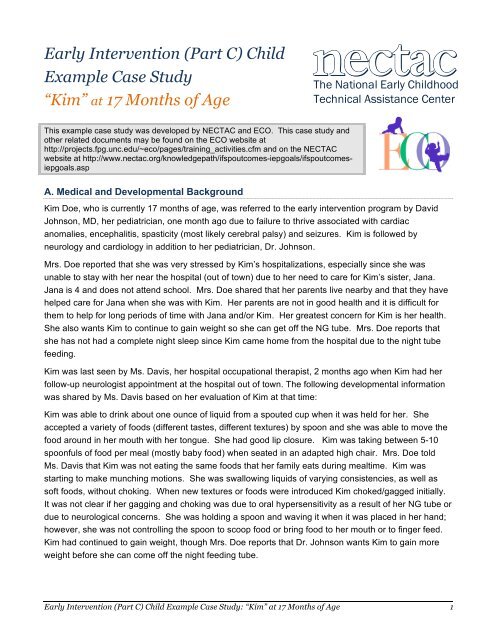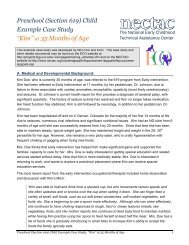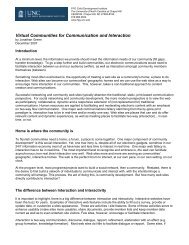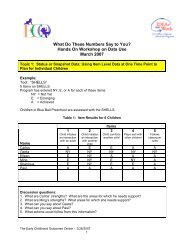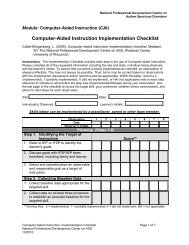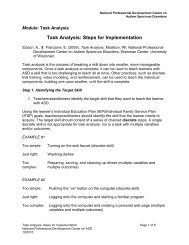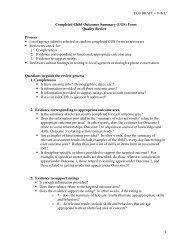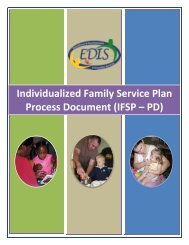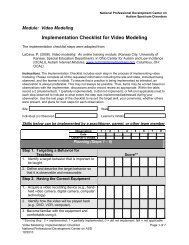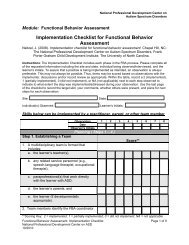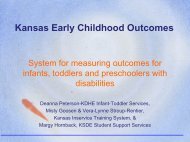Early Intervention (Part C) Child Example Case Study “Kim” at 17 ...
Early Intervention (Part C) Child Example Case Study “Kim” at 17 ...
Early Intervention (Part C) Child Example Case Study “Kim” at 17 ...
You also want an ePaper? Increase the reach of your titles
YUMPU automatically turns print PDFs into web optimized ePapers that Google loves.
<strong>Early</strong> <strong>Intervention</strong> (<strong>Part</strong> C) <strong>Child</strong><br />
<strong>Example</strong> <strong>Case</strong> <strong>Study</strong><br />
<strong>“Kim”</strong> <strong>at</strong> <strong>17</strong> Months of Age<br />
The N<strong>at</strong>ional <strong>Early</strong> <strong>Child</strong>hood<br />
Technical Assistance Center<br />
This example case study was developed by NECTAC and ECO. This case study and<br />
other rel<strong>at</strong>ed documents may be found on the ECO website <strong>at</strong><br />
http://projects.fpg.unc.edu/~eco/pages/training_activities.cfm and on the NECTAC<br />
website <strong>at</strong> http://www.nectac.org/knowledgep<strong>at</strong>h/ifspoutcomes-iepgoals/ifspoutcomesiepgoals.asp<br />
A. Medical and Developmental Background<br />
Kim Doe, who is currently <strong>17</strong> months of age, was referred to the early intervention program by David<br />
Johnson, MD, her pedi<strong>at</strong>rician, one month ago due to failure to thrive associ<strong>at</strong>ed with cardiac<br />
anomalies, encephalitis, spasticity (most likely cerebral palsy) and seizures. Kim is followed by<br />
neurology and cardiology in addition to her pedi<strong>at</strong>rician, Dr. Johnson.<br />
Mrs. Doe reported th<strong>at</strong> she was very stressed by Kim’s hospitaliz<strong>at</strong>ions, especially since she was<br />
unable to stay with her near the hospital (out of town) due to her need to care for Kim’s sister, Jana.<br />
Jana is 4 and does not <strong>at</strong>tend school. Mrs. Doe shared th<strong>at</strong> her parents live nearby and th<strong>at</strong> they have<br />
helped care for Jana when she was with Kim. Her parents are not in good health and it is difficult for<br />
them to help for long periods of time with Jana and/or Kim. Her gre<strong>at</strong>est concern for Kim is her health.<br />
She also wants Kim to continue to gain weight so she can get off the NG tube. Mrs. Doe reports th<strong>at</strong><br />
she has not had a complete night sleep since Kim came home from the hospital due to the night tube<br />
feeding.<br />
Kim was last seen by Ms. Davis, her hospital occup<strong>at</strong>ional therapist, 2 months ago when Kim had her<br />
follow-up neurologist appointment <strong>at</strong> the hospital out of town. The following developmental inform<strong>at</strong>ion<br />
was shared by Ms. Davis based on her evalu<strong>at</strong>ion of Kim <strong>at</strong> th<strong>at</strong> time:<br />
Kim was able to drink about one ounce of liquid from a spouted cup when it was held for her. She<br />
accepted a variety of foods (different tastes, different textures) by spoon and she was able to move the<br />
food around in her mouth with her tongue. She had good lip closure. Kim was taking between 5-10<br />
spoonfuls of food per meal (mostly baby food) when se<strong>at</strong>ed in an adapted high chair. Mrs. Doe told<br />
Ms. Davis th<strong>at</strong> Kim was not e<strong>at</strong>ing the same foods th<strong>at</strong> her family e<strong>at</strong>s during mealtime. Kim was<br />
starting to make munching motions. She was swallowing liquids of varying consistencies, as well as<br />
soft foods, without choking. When new textures or foods were introduced Kim choked/gagged initially.<br />
It was not clear if her gagging and choking was due to oral hypersensitivity as a result of her NG tube or<br />
due to neurological concerns. She was holding a spoon and waving it when it was placed in her hand;<br />
however, she was not controlling the spoon to scoop food or bring food to her mouth or to finger feed.<br />
Kim had continued to gain weight, though Mrs. Doe reports th<strong>at</strong> Dr. Johnson wants Kim to gain more<br />
weight before she can come off the night feeding tube.<br />
<strong>Early</strong> <strong>Intervention</strong> (<strong>Part</strong> C) <strong>Child</strong> <strong>Example</strong> <strong>Case</strong> <strong>Study</strong>: <strong>“Kim”</strong> <strong>at</strong> <strong>17</strong> Months of Age 1
Kim was not able to assist with dressing due to significant challenges in moving her arms and legs.<br />
She <strong>at</strong>tempted to move her arms and legs when dressing but due to spasticity was unable to control<br />
her movements. Mrs. Doe reported th<strong>at</strong> Kim enjoyed b<strong>at</strong>h time.<br />
Kim was playing by reaching for and b<strong>at</strong>ting toys, touching pictures and making sounds, and w<strong>at</strong>ching<br />
and making sounds in response to wh<strong>at</strong> happened around her. Mrs. Doe described the sound as a<br />
“gutteral sound in the back of her thro<strong>at</strong>.” She was <strong>at</strong>tempting to engage in imit<strong>at</strong>ive sound play by<br />
making thro<strong>at</strong>y sounds following sounds made by others. She was not babbling or making consonant<br />
sounds, which Ms. Davis believed was most likely due to her NG tube since she appeared to have<br />
good movement of her lips and tongue. Mrs. Doe reported th<strong>at</strong> Kim sometimes used gestures and<br />
sounds to let her mom and dad know when she wanted to be picked up, when she was full or didn’t like<br />
a particular food. Kim sometimes made choices about which book she wanted to have read to her.<br />
Mrs. Doe informed Ms. Davis th<strong>at</strong> Kim cries and fusses when she is not understood (and this was<br />
happening several times every day):<br />
“Kim was able to support her head well when in an adapted se<strong>at</strong>, when she was held either in<br />
sitting or standing supported <strong>at</strong> her trunk, and when on her tummy or side. She was able to<br />
balance momentarily when propped in the sitting position (hands on the floor or on her knees),<br />
but was not able to regain her balance or get herself into the sitting position. She lifted her head<br />
and used her abdominals to help get to sitting when assisted to sit toward one side. Kim was<br />
able to roll by herself from her stomach to her back but with some difficulty. Kim was also able<br />
to roll from her back to her stomach. She moved short distances forward, sideways and<br />
backwards lying on her stomach mostly by twisting her body to inch along, though she was<br />
trying to pull with her arms and to push with her legs. She was motiv<strong>at</strong>ed to move to get her<br />
toys although she was not able to move far.<br />
Kim appeared to enjoy being with adults and other children. When with other children,<br />
especially her sister, Kim w<strong>at</strong>ched them, laughed, and <strong>at</strong>tempted to imit<strong>at</strong>e sounds they made.<br />
Kim enjoyed sound play with her sister and her mother. She had a preference for toys th<strong>at</strong><br />
made sounds (by moving to, looking <strong>at</strong> and/or smiling when the toy was presented to her). She<br />
especially liked ones th<strong>at</strong> played tunes. She showed recognition of a number of toys and<br />
objects by looking <strong>at</strong> them when they were named.<br />
Kim reached with both hands and was able to move objects by swiping <strong>at</strong> them. She p<strong>at</strong>ted<br />
pictures and banged toys. She was able to grasp toys and other objects th<strong>at</strong> were placed in her<br />
hand, but was not able to consistently open her hand to pick up an object by herself. She did<br />
not bring toys or hands to her mouth due to spasticity.”<br />
B. Family Routines and Priorities<br />
Wh<strong>at</strong> are the daily routines/activities of your child and family (where and with whom your child<br />
spends time)<br />
o<br />
Jana usually is up before Kim in the morning so Mrs. Doe has time to feed Jana and get her<br />
dressed before Kim gets up.<br />
<strong>Early</strong> <strong>Intervention</strong> (<strong>Part</strong> C) <strong>Child</strong> <strong>Example</strong> <strong>Case</strong> <strong>Study</strong>: <strong>“Kim”</strong> <strong>at</strong> <strong>17</strong> Months of Age 2
o<br />
o<br />
o<br />
o<br />
o<br />
o<br />
o<br />
o<br />
During the week when Mr. Doe is working, Mrs. Doe spends most of the time <strong>at</strong> home during the<br />
day with Kim and Jana. She is beginning to do some errands with the girls during the day now th<strong>at</strong><br />
Kim is healthy – she had been doing shopping <strong>at</strong> night when Mr. Doe could be <strong>at</strong> home with Kim.<br />
Kim e<strong>at</strong>s small meals every 3-4 hours. She is tube fed twice a day, around 1:00 AM and around<br />
1:00 PM – she will be weaned from the lunch feeding within the next week or so. Mrs. Doe<br />
prepares different foods for Kim than the rest of the family.<br />
Kim likes to play on the living floor with Jana. She does so several times a day. Jana likes to<br />
interact with Kim during the play time, showing her books and toys, and <strong>at</strong>tempting to engage her in<br />
play.<br />
Mrs. Doe’s parents live close by and visit several times during the day each week. They almost<br />
always spend time with Kim and Jana after church on Sundays.<br />
Jana plays with neighborhood children almost everyday and Kim likes to w<strong>at</strong>ch them play and<br />
seems to want to play with them.<br />
Jana usually naps around 2:00 PM everyday and Kim naps around 3:00. Mrs. Doe has about an<br />
hour each day to do chores <strong>at</strong> home when both girls are napping.<br />
Jana goes to bed <strong>at</strong> night around 8:00 and Kim goes to bed around 9:30. Mr. And Mrs. Doe usually<br />
go to bed around 10:00.<br />
Mr. Doe and Kim’s grandparents are “uncomfortable” feeding Kim and spending long periods of<br />
time caring for her. Mr. Doe is not home a lot due to his long hours of work.<br />
Are there other routines or activities you would like to establish These can be routines or<br />
activities th<strong>at</strong> your family would like to do now or in the future.<br />
o<br />
o<br />
o<br />
o<br />
Mrs. Doe would like to be able to have the family e<strong>at</strong> the same foods <strong>at</strong> mealtime and not have to<br />
feed Kim different foods. Mrs. Doe has been working on introducing new textures and different<br />
foods over the past several months. Kim still gags when new textures/tastes are introduced but<br />
gagging reduces as she adjusts to the foods.<br />
Mrs. Doe would like the girls to be on the same sleep schedule so she has some time to herself and<br />
to do household chores.<br />
Mrs. Doe would like Kim to be around children her own age, especially since she really enjoys<br />
w<strong>at</strong>ching Jana play with neighbor children. Mrs. Doe would like to explore some child care, respite<br />
care opportunities for Kim.<br />
Mrs. Doe would like to have more support from Mr. Doe and Kim’s grandparents in caring for Kim<br />
and Jana. She is hoping th<strong>at</strong> Kim’s grandparents will be more willing to help with Kim when she is<br />
able to e<strong>at</strong> table foods and not gag. Mrs. Doe understands their reluctance and also recognizes<br />
th<strong>at</strong> they are not in the best of health. She knows th<strong>at</strong> caring for Kim is stressful for them – they are<br />
afraid they will do something to ‘hurt” Kim.<br />
<strong>Early</strong> <strong>Intervention</strong> (<strong>Part</strong> C) <strong>Child</strong> <strong>Example</strong> <strong>Case</strong> <strong>Study</strong>: <strong>“Kim”</strong> <strong>at</strong> <strong>17</strong> Months of Age 3
Who are the people and wh<strong>at</strong> are the toys, activities, routines, and places your child enjoys the<br />
most<br />
o<br />
o<br />
o<br />
o<br />
o<br />
Kim likes riding in the car. The Doe’s have a car se<strong>at</strong> for Kim th<strong>at</strong> with guidance from the OT <strong>at</strong> the<br />
hospital they have adapted.<br />
Kim likes to be read books by her grandparents. She also enjoys playing games with them (peek-aboo,<br />
p<strong>at</strong>-a-cake)<br />
She likes toys th<strong>at</strong> make sound.<br />
She likes to w<strong>at</strong>ch Jana and the neighbor children play. She especially likes Jana to interact with<br />
her, showing her toys and books.<br />
Kim enjoys being with most adults, especially her grandparents.<br />
Which routines or activities are challenging for you or your child<br />
o<br />
o<br />
Mealtime<br />
Nap and bedtime<br />
Wh<strong>at</strong> are your family concerns rel<strong>at</strong>ed to your child’s development (Including anything your<br />
family identifies th<strong>at</strong> would help to improve your ability to meet the needs of your child)<br />
o<br />
o<br />
o<br />
o<br />
o<br />
o<br />
o<br />
Kim gags and chokes when new foods/liquids are introduced and Kim’s mom has to spend a good<br />
amount of time working to help Kim overcome her dislikes of new foods and textures – Kim’s mom<br />
is concerned about how long it will take to transition Kim to table food th<strong>at</strong> the rest of the family<br />
e<strong>at</strong>s.<br />
Kim and her sister are not on the same sleep schedule (going to bed, awaking in the morning or<br />
napping during the day) so Kim’s mom doesn’t always finish all of her chores and is frequently tired<br />
as Kim does not yet sleep through the night.<br />
Several times a day, Kim cries and fusses because Kim’s parents and sister do not always<br />
understand wh<strong>at</strong> she wants or needs.<br />
Kim <strong>at</strong>tempts to initi<strong>at</strong>e play with her sister but is unable to move very far around the living room on<br />
her own and is unable to tell her sister wh<strong>at</strong> she wants to play with.<br />
Grandmother doesn’t like to feed Kim because she gags/chokes on new foods.<br />
Kim is fed every 3-4 hours during the day and is on a feeding tube <strong>at</strong> night.<br />
Kim wakes several times during the night taking 10-15 minutes to get back to sleep.<br />
Wh<strong>at</strong> are your family priorities rel<strong>at</strong>ed to your child’s development<br />
Kim’s mom has prioritized the following concerns to be addressed immedi<strong>at</strong>ely by the team:<br />
o<br />
o<br />
o<br />
Would like Kim to sleep through the night and get both Kim and her sister on the same sleep routine<br />
so Kim’s mom feels rested and better able to do daily chores.<br />
Would like Kim to be able to gain enough weight to be off the night tube feeding and for Kim to be<br />
able to e<strong>at</strong> table foods with the rest of the family <strong>at</strong> meal times.<br />
Would like Kim to be able to let people know wh<strong>at</strong> she wants.<br />
<strong>Early</strong> <strong>Intervention</strong> (<strong>Part</strong> C) <strong>Child</strong> <strong>Example</strong> <strong>Case</strong> <strong>Study</strong>: <strong>“Kim”</strong> <strong>at</strong> <strong>17</strong> Months of Age 4
Wh<strong>at</strong> are your family resources, including family, friends, community groups, financial<br />
supports, etc., th<strong>at</strong> are helpful to you<br />
o<br />
o<br />
o<br />
o<br />
Kim usually spends her day <strong>at</strong> home with her mom and sister.<br />
Kim’s m<strong>at</strong>ernal grandparents spend time with Kim and her family almost every Sunday after the<br />
family returns from church. Her grandparents are helpful with Kim and Jana.<br />
Transporting Kim to the store, church, etc. is easy.<br />
Kim spends about 30 minutes 2x/day playing on the living room floor with her sister.<br />
C. <strong>Child</strong> Developmental Inform<strong>at</strong>ion<br />
<strong>Child</strong> Strengths: At <strong>17</strong> months of age, wh<strong>at</strong>’s working well for Kim is she is able to drink from a<br />
spouted cut (about 1 oz. of liquid) if the cup is held for her. She accepts a variety of foods (different<br />
tastes, textures) by spoon when fed, holds a spoon when placed in her hand and waves and bangs it.<br />
She is swallowing liquids of varying consistencies, as well as soft foods, without choking. Kim w<strong>at</strong>ches<br />
people and is very interested in wh<strong>at</strong> is happening around her; recognizes and enjoys familiar people<br />
and children, likes toys th<strong>at</strong> make sounds, shows recognition of toys and objects by looking <strong>at</strong> them<br />
when named. Kim plays by reaching for and b<strong>at</strong>ting toys, p<strong>at</strong>ting pictures, holds toys when placed in<br />
her hand. Kim is able to hold her head up when in her adapted se<strong>at</strong>, held supported in a sitting or<br />
standing position or when on her tummy or her side; sits momentarily when propped in a sitting<br />
position, She lifts her head and uses her abdominals to help get to sitting. She is able to roll from her<br />
back to her stomach and moves short distances forward, sideways and backwards lying on her<br />
stomach (twisting her body to inch along. She is motiv<strong>at</strong>ed to move to get her toys, although she is not<br />
able to move very far. Kim is able to make thro<strong>at</strong>y sounds and gestures to let her family know when<br />
she wants to be picked up, when she is full or doesn’t like a particular food; sometimes makes sounds<br />
and gestures to indic<strong>at</strong>e wh<strong>at</strong> books she wants read to her; enjoys sound play with familiar adults and<br />
children and <strong>at</strong>tempts to imit<strong>at</strong>e sounds. Kim enjoys being with familiar adults and children; she<br />
w<strong>at</strong>ches other children, frequently laughing and smiling <strong>at</strong> others, cries and fusses when she is not<br />
understood (several times a day).<br />
<strong>Child</strong> Concerns: Some of Kim’s challenges or needs include choking or gagging when new foods are<br />
introduced, does not scoop food or bring spoon to mouth, does not finger feed, needs assistance when<br />
drinking from a cup, is not able to assist with dressing or b<strong>at</strong>hing.<br />
Assessment Summary: Assessment included observ<strong>at</strong>ions, interview with mother and use of the<br />
<strong>Early</strong> Learning Accomplishment Profile (E-LAP) as the primary source for estim<strong>at</strong>ed developmental age<br />
in months. 1<br />
Expressive and Receptive Language: (5-6 months) Kim is making thro<strong>at</strong>y sounds and<br />
gestures to let her parents know when she wants (i.e., when she wants to be picked up, is full or<br />
doesn’t like a food, or wants a particular book). Kim enjoys sound play with adults and children<br />
and <strong>at</strong>tempts to imit<strong>at</strong>e sounds and toys th<strong>at</strong> make sounds. Her ability to make sounds may<br />
have been affected by the presence of the NG tube.<br />
1 Use of the E-LAP in this case study is not intended to be a specific endorsement of a specific tool, nor<br />
a st<strong>at</strong>ement of the quality of the tool for use in the outcomes measurement or IFSP planning process.<br />
<strong>Early</strong> <strong>Intervention</strong> (<strong>Part</strong> C) <strong>Child</strong> <strong>Example</strong> <strong>Case</strong> <strong>Study</strong>: <strong>“Kim”</strong> <strong>at</strong> <strong>17</strong> Months of Age 5
Gross Motor: (6 months) Kim is able to hold her head up when in her adapted se<strong>at</strong>, is held in a<br />
sitting or standing position and when on her tummy or sided. She is able to sit momentarily<br />
when propped in a sitting position with hands on floor. She is able to roll by herself from her<br />
stomach to her back with difficulty. She is able to move short distances forward (twisting her<br />
body to inch along) and is motiv<strong>at</strong>ed to get her toys. Kim is challenged by her limited movement<br />
to be able particip<strong>at</strong>e in independent feeding and/or dressing.<br />
Fine Motor: (4 months) Kim plays by reaching for and b<strong>at</strong>ting toys, p<strong>at</strong>ting pictures and banging<br />
toys, holds toys when placed in her hand. She is able to hold objects (toys, spoon) if placed in<br />
her hand. Kim is challenged by her limited movement to be able to explore her environment<br />
and play.<br />
Cognitive: (7 – 8 months with sc<strong>at</strong>tering to 14 months) Kim w<strong>at</strong>ches people and is very<br />
interested in wh<strong>at</strong> is happening around her; looks for toys when dropped or rolled from view;<br />
likes toys with sound, and shows some recognition of objects when named, and recognizes<br />
mom, dad, sister, grandparents. It is difficult to determine Kim’s level of understanding due to<br />
her motor challenges and limited ways of communic<strong>at</strong>ing thoughts, wants and needs.<br />
Social-Emotional: (6 – 9 months) Kim enjoys being with familiar adults and children. She<br />
w<strong>at</strong>ches children and adults, laughs and smiles <strong>at</strong> others. She cries and fusses when she is not<br />
understood. The NG tube affects her sleeping <strong>at</strong> night, which leaves Kim fussy during the day.<br />
Adaptive: (Under 6 months) Kim is able to drink a 1 ounce of liquid <strong>at</strong> a time out of a cup held<br />
for her. She is accepting a variety of foods (different textures and tastes) by spoon; however,<br />
while she is holding a spoon, she is unable to bring it to her mouth. She is not able to assist in<br />
dressing or b<strong>at</strong>hing due to her motor challenges.<br />
Hearing: (Normal) Passed Newborn Hearing Screen and subsequent screens by her physician.<br />
Next well-baby check is <strong>at</strong> 18 months<br />
Vision: (Normal) physician checks vision <strong>at</strong> each well-baby check and no concerns. Next wellbaby<br />
check is <strong>at</strong> 18 months.<br />
Health: Kim has been hospitalized off and on out of town for the majority of her first 16 months<br />
of life due to seizures, numerous viral infections and significant nutritional issues. Kim has had<br />
an NG tube since 6 months of age. Repe<strong>at</strong>ed efforts have been made to wean Kim from the<br />
NG tube, however, her illnesses prevented th<strong>at</strong> from occurring. Kim has been home from the<br />
hospital for the past 3 months and has been healthy since th<strong>at</strong> time. Her primary care physician<br />
and his nutritionist have made significant gains in weaning Kim from the tube feedings since th<strong>at</strong><br />
time due to improved health and weight gain. Kim is currently is tube fed twice daily – <strong>at</strong> noon<br />
and during the night. The goal is to ensure sufficient weight gain and removal of Kim’s NG tube<br />
by l<strong>at</strong>e summer. She is being weaned off her seizure medic<strong>at</strong>ion. Recent EEG shows no<br />
seizure activity.<br />
<strong>Early</strong> <strong>Intervention</strong> (<strong>Part</strong> C) <strong>Child</strong> <strong>Example</strong> <strong>Case</strong> <strong>Study</strong>: <strong>“Kim”</strong> <strong>at</strong> <strong>17</strong> Months of Age 6


